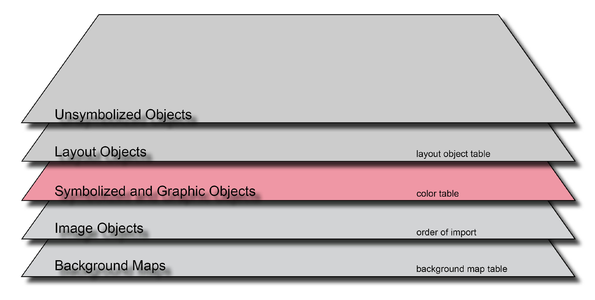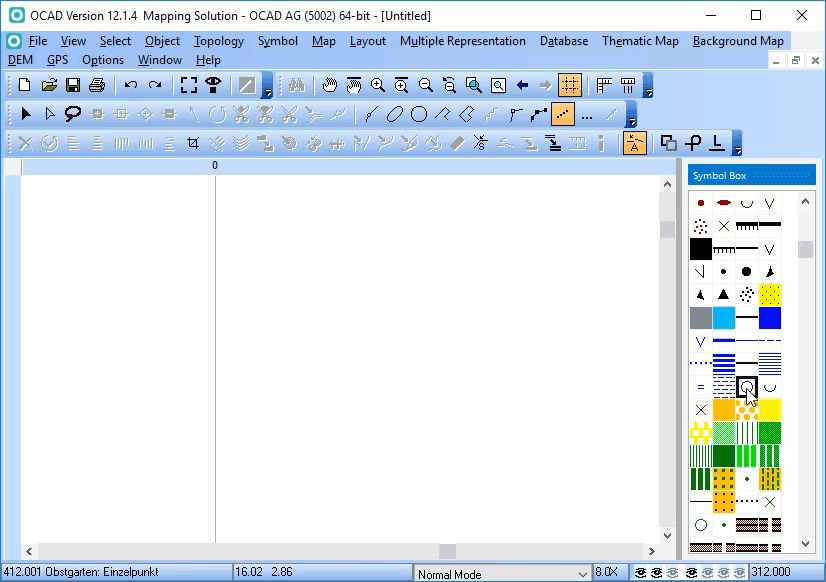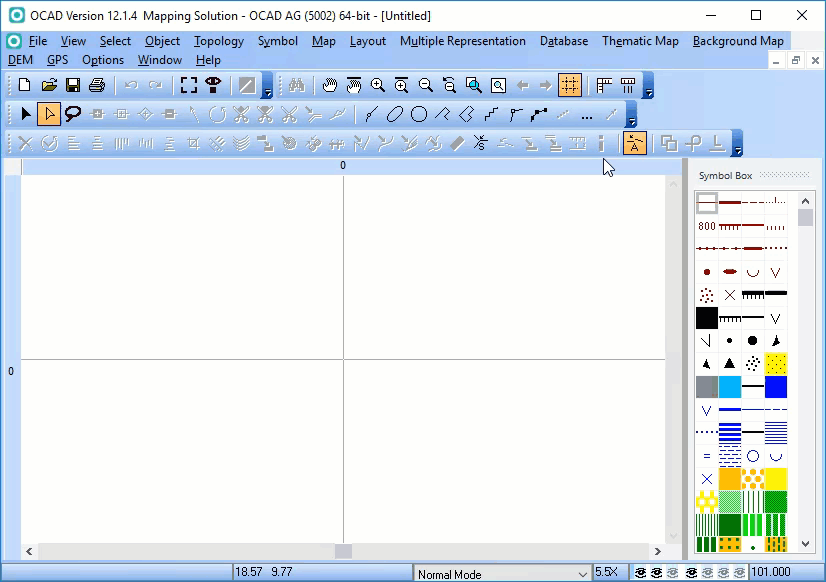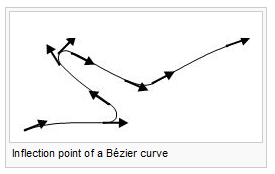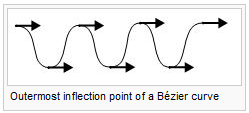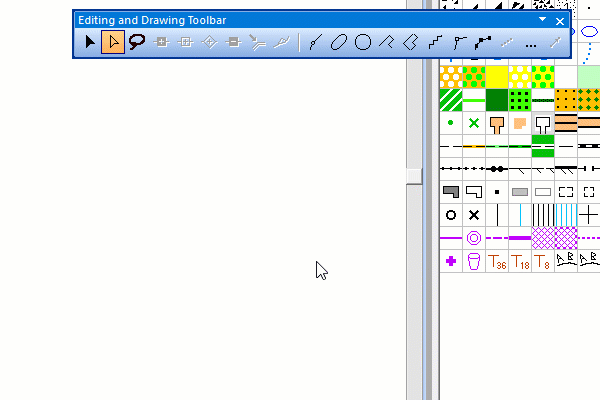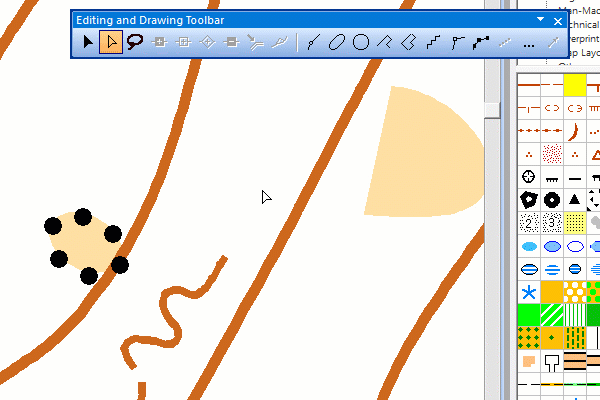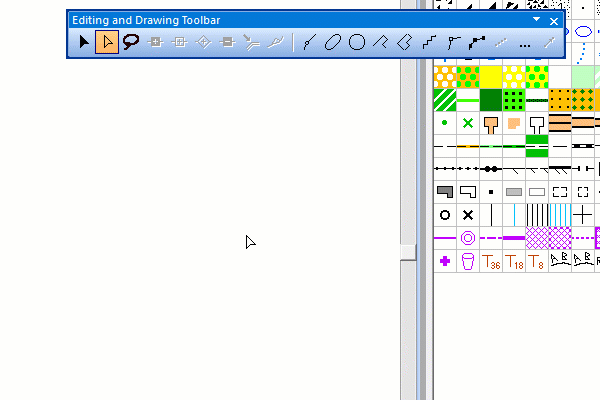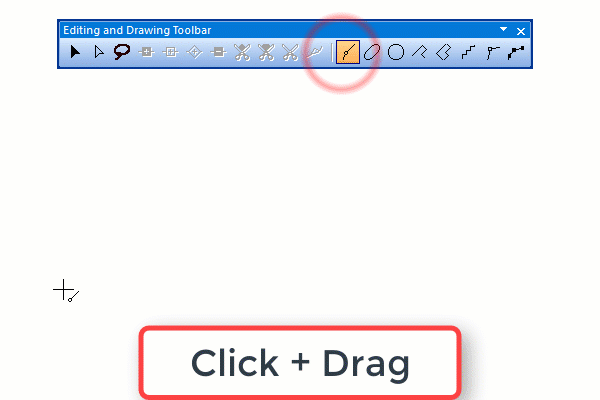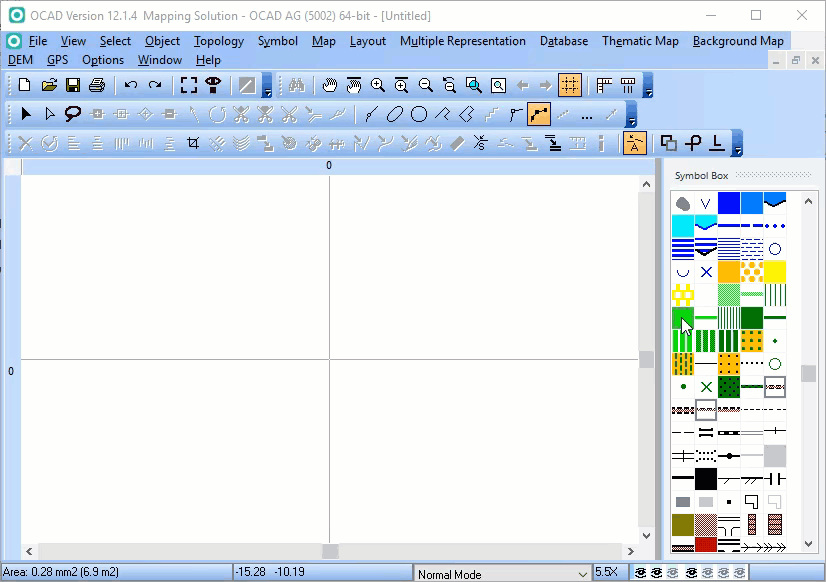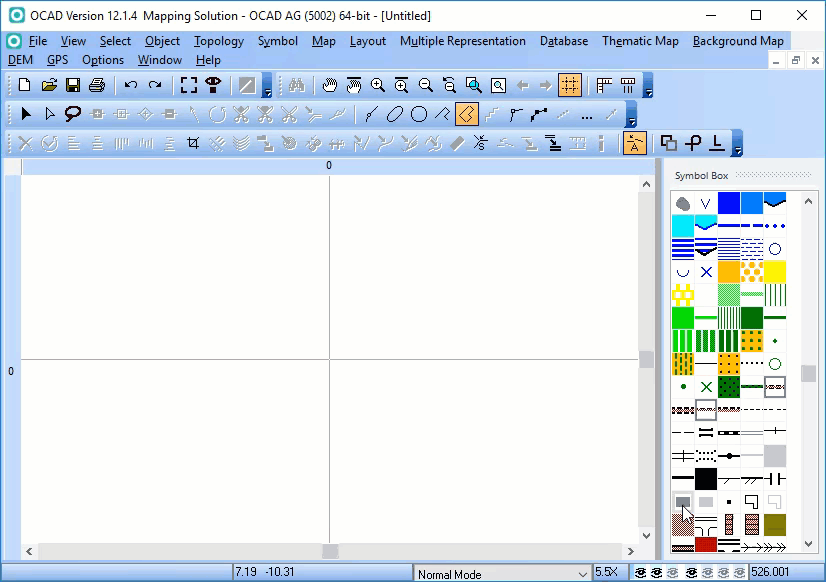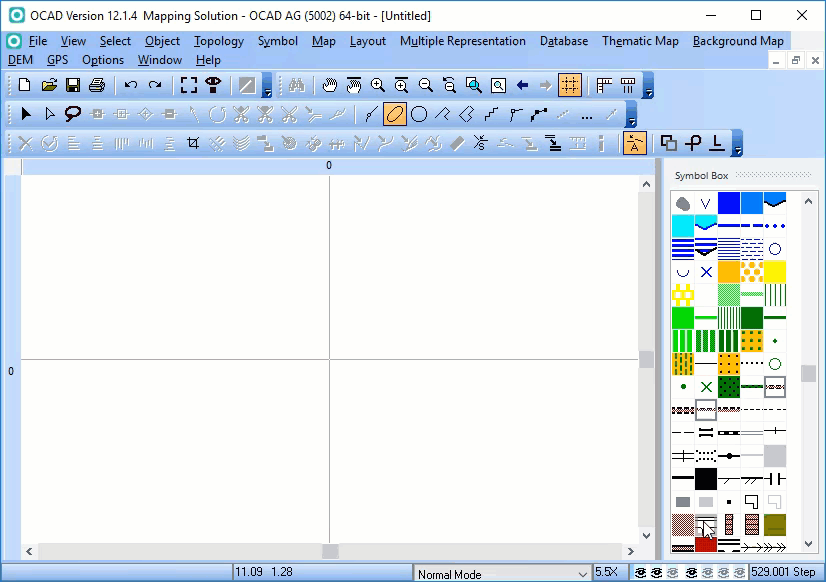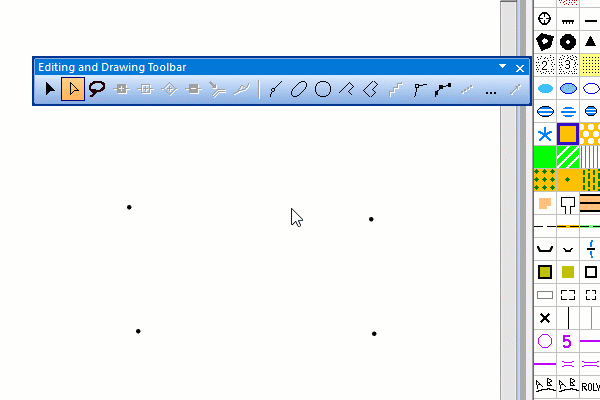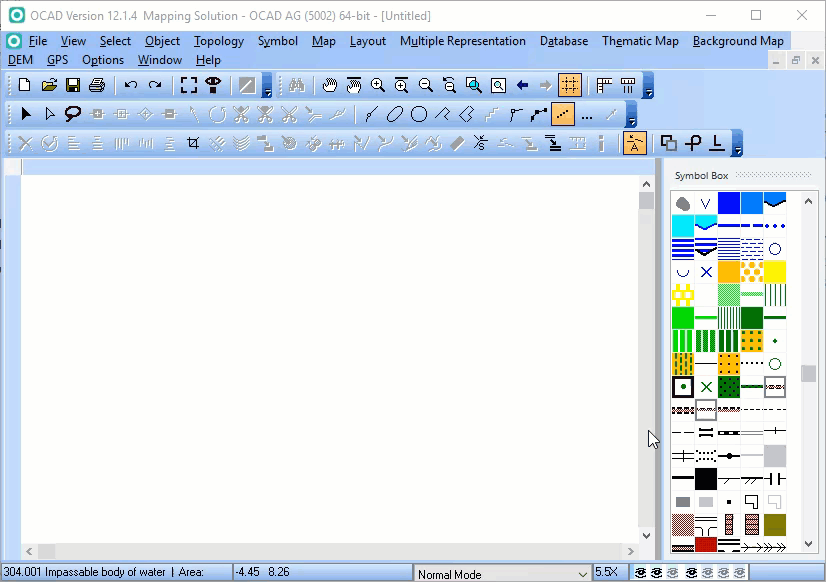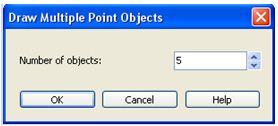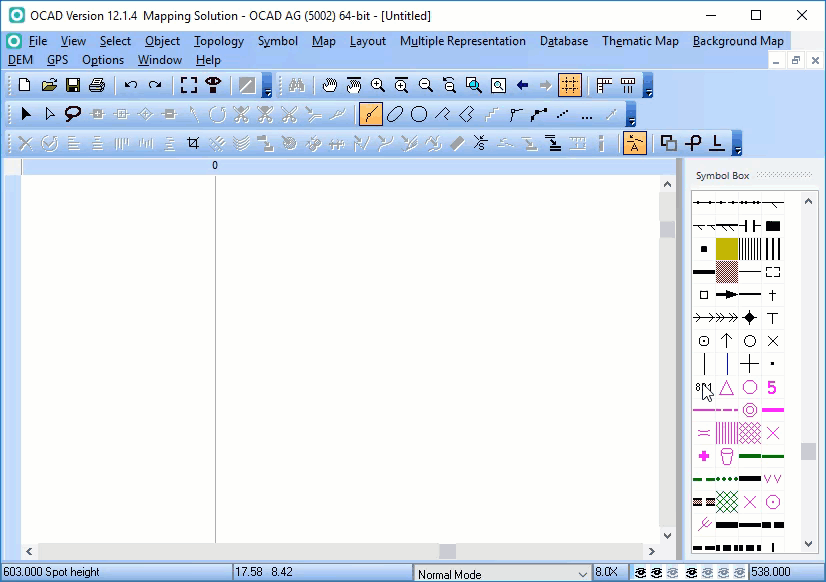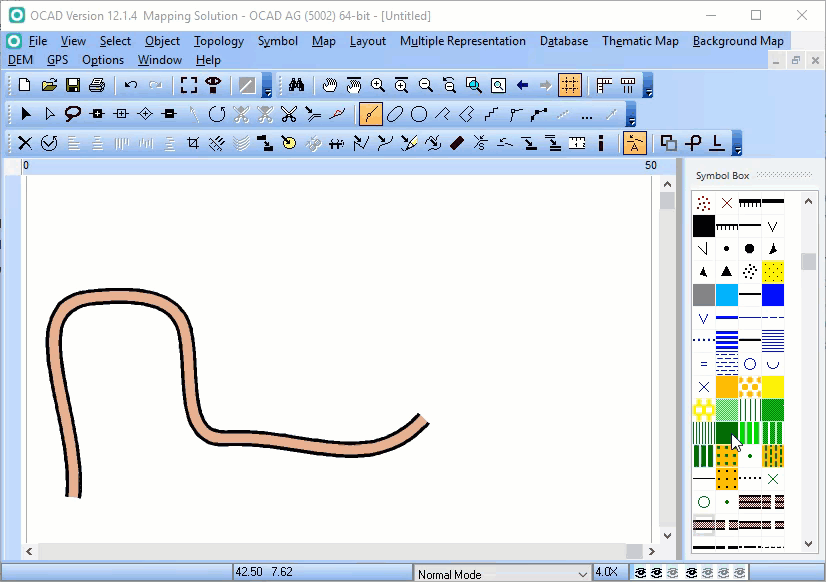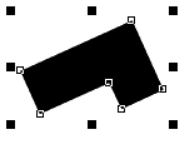Drawing an Object: Difference between revisions
(/* Place a Text Object File:Space.PNGThis function is available in OCAD Mapping Solution.|link=https://www.ocad.com/en/products/ocad-for-cartographyThis function is available in OCAD Orienteering.|link=https://www.ocad.com/en/products/ocad-for-orientee...) |
|||
| (3 intermediate revisions by the same user not shown) | |||
| Line 12: | Line 12: | ||
:[[File:Hint.jpg|hint]] -To define a specific direction of for the object, click and hold the left mouse button on desired position; then drag to the direction you wish the object to be oriented to. | :[[File:Hint.jpg|hint]] -To define a specific direction of for the object, click and hold the left mouse button on desired position; then drag to the direction you wish the object to be oriented to. | ||
:: -The object can be adjusted retrospectively. To do this, select the point object and align it using the '''Indicate direction of area pattern, point or text object''' function. | :: -The object can be adjusted retrospectively. To do this, select the point object and align it using the '''Indicate direction of area pattern, point or text object''' function. | ||
==Draw a Line or Area Object [[File:Space.PNG]][[File:Mas40px.PNG|This function is available in OCAD Mapping Solution.|link=https://www.ocad.com/en/products/ocad-for-cartography]][[File:Ori40px.PNG|This function is available in OCAD Orienteering.|link=https://www.ocad.com/en/products/ocad-for-orienteering]][[File:Sta40px.PNG|This function is available in OCAD Starter.|link=https://www.ocad.com/en/products/ocad-for-orienteering]][[File:CS40px.PNG|This function is available in OCAD Course Setting.|link=https://www.ocad.com/en/products/ocad-for-orienteering]]== | ==Draw a Line or Area Object [[File:Space.PNG]][[File:Mas40px.PNG|This function is available in OCAD Mapping Solution.|link=https://www.ocad.com/en/products/ocad-for-cartography]][[File:Ori40px.PNG|This function is available in OCAD Orienteering.|link=https://www.ocad.com/en/products/ocad-for-orienteering]][[File:Sta40px.PNG|This function is available in OCAD Starter.|link=https://www.ocad.com/en/products/ocad-for-orienteering]][[File:CS40px.PNG|This function is available in OCAD Course Setting.|link=https://www.ocad.com/en/products/ocad-for-orienteering]]== | ||
| Line 33: | Line 32: | ||
# Click the left mouse button when you have finished drawing and the help line is transformed into the selected line or area symbol. | # Click the left mouse button when you have finished drawing and the help line is transformed into the selected line or area symbol. | ||
==Draw a Curve [[File:Space.PNG]][[File:Mas40px.PNG|This function is available in OCAD Mapping Solution.|link=https://www.ocad.com/en/products/ocad-for-cartography]][[File:Ori40px.PNG|This function is available in OCAD Orienteering.|link=https://www.ocad.com/en/products/ocad-for-orienteering]][[File:Sta40px.PNG|This function is available in OCAD Starter.|link=https://www.ocad.com/en/products/ocad-for-orienteering]][[File:CS40px.PNG|This function is available in OCAD Course Setting.|link=https://www.ocad.com/en/products/ocad-for-orienteering]]== | ==Draw a Curve [[File:Space.PNG]][[File:Mas40px.PNG|This function is available in OCAD Mapping Solution.|link=https://www.ocad.com/en/products/ocad-for-cartography]][[File:Ori40px.PNG|This function is available in OCAD Orienteering.|link=https://www.ocad.com/en/products/ocad-for-orienteering]][[File:Sta40px.PNG|This function is available in OCAD Starter.|link=https://www.ocad.com/en/products/ocad-for-orienteering]][[File:CS40px.PNG|This function is available in OCAD Course Setting.|link=https://www.ocad.com/en/products/ocad-for-orienteering]]== | ||
| Line 60: | Line 58: | ||
:[[File:Hint.jpg|hint]]You can force a corner vertex by dragging two tangents from the same vertex point. '''Curve:''' Tangents 2 and 3 start at the same point but move in different directions. A corner vertex is created. | :[[File:Hint.jpg|hint]]You can force a corner vertex by dragging two tangents from the same vertex point. '''Curve:''' Tangents 2 and 3 start at the same point but move in different directions. A corner vertex is created. | ||
:[[File:CreateACornerVertexInABezierCurve.PNG|Create a corner vertex in a Bézier curve]] | :[[File:CreateACornerVertexInABezierCurve.PNG|Create a corner vertex in a Bézier curve]] | ||
==== Change Drawing Mode==== | ==== Change Drawing Mode==== | ||
You can draw parts of a line or area object using different drawing modes. Select the appropriate symbol and draw the first part of your object using a drawing mode. Now press the '''Tab button''' until the desired drawing mode appears and then continue drawing. | You can draw parts of a line or area object using different drawing modes. Select the appropriate symbol and draw the first part of your object using a drawing mode. Now press the '''Tab button''' until the desired drawing mode appears and then continue drawing. | ||
| Line 72: | Line 70: | ||
[[File:ContinueLineArea.gif]] | [[File:ContinueLineArea.gif]] | ||
==== Draw Horizontal Lines==== | ==== Draw Horizontal Lines==== | ||
| Line 87: | Line 83: | ||
Start drawing the curve. To draw a straight line click in the drawing area and release the left mouse button. So you can easy switch between straight line mode and curve mode. Double click the left mouse button to finish drawing. | Start drawing the curve. To draw a straight line click in the drawing area and release the left mouse button. So you can easy switch between straight line mode and curve mode. Double click the left mouse button to finish drawing. | ||
To finish the object with the right mouse button change the corresponding setting in '''[[OCAD_Preferences#Right_click_in_drawing_area_opens_context_menu|Right click in drawing area opens context menu]]''' | |||
[[File:ChangeToStraightLineMode.gif]] | [[File:ChangeToStraightLineMode.gif]] | ||
| Line 113: | Line 111: | ||
You should always draw the longest side of a rectangular area first since it is easier to define the rectangular orientation of an area from the longer side. | You should always draw the longest side of a rectangular area first since it is easier to define the rectangular orientation of an area from the longer side. | ||
: [[File:DrawARectangularAreaOrLine.PNG|Draw a rectangular area or line]] | : [[File:DrawARectangularAreaOrLine.PNG|Draw a rectangular area or line]] | ||
==Draw a Rectangular Line [[File:Space.PNG]][[File:Mas40px.PNG|This function is available in OCAD Mapping Solution.|link=https://www.ocad.com/en/products/ocad-for-cartography]][[File:Ori40px.PNG|This function is available in OCAD Orienteering.|link=https://www.ocad.com/en/products/ocad-for-orienteering]]== | ==Draw a Rectangular Line [[File:Space.PNG]][[File:Mas40px.PNG|This function is available in OCAD Mapping Solution.|link=https://www.ocad.com/en/products/ocad-for-cartography]][[File:Ori40px.PNG|This function is available in OCAD Orienteering.|link=https://www.ocad.com/en/products/ocad-for-orienteering]]== | ||
| Line 150: | Line 147: | ||
:: -You can also drag the circle from the center point. Simply press and hold the '''Shift''' [[File:Shift.JPG|shift]] button and drag a radius. | :: -You can also drag the circle from the center point. Simply press and hold the '''Shift''' [[File:Shift.JPG|shift]] button and drag a radius. | ||
:: -Clicking the center of the circle with the right mouse button without dragging displays the '''Draw Circle''' dialog box. Here you can enter the radius of the circle in mm or m. | :: -Clicking the center of the circle with the right mouse button without dragging displays the '''Draw Circle''' dialog box. Here you can enter the radius of the circle in mm or m. | ||
==Draw an Elliptical Object [[File:Space.PNG]][[File:Mas40px.PNG|This function is available in OCAD Mapping Solution.|link=https://www.ocad.com/en/products/ocad-for-cartography]][[File:Ori40px.PNG|This function is available in OCAD Orienteering.|link=https://www.ocad.com/en/products/ocad-for-orienteering]][[File:Sta40px.PNG|This function is available in OCAD Starter.|link=https://www.ocad.com/en/products/ocad-for-orienteering]]== | ==Draw an Elliptical Object [[File:Space.PNG]][[File:Mas40px.PNG|This function is available in OCAD Mapping Solution.|link=https://www.ocad.com/en/products/ocad-for-cartography]][[File:Ori40px.PNG|This function is available in OCAD Orienteering.|link=https://www.ocad.com/en/products/ocad-for-orienteering]][[File:Sta40px.PNG|This function is available in OCAD Starter.|link=https://www.ocad.com/en/products/ocad-for-orienteering]]== | ||
| Line 163: | Line 159: | ||
:[[File:DrawAnEllipse.PNG|Draw an ellipse]] | :[[File:DrawAnEllipse.PNG|Draw an ellipse]] | ||
:[[File:Hint.jpg|hint]] The outline or ellipse line is drawn as a Bézier curve. | :[[File:Hint.jpg|hint]] The outline or ellipse line is drawn as a Bézier curve. | ||
==Draw Multiple Point Objects [[File:Space.PNG]][[File:Mas40px.PNG|This function is available in OCAD Mapping Solution.|link=https://www.ocad.com/en/products/ocad-for-cartography]][[File:Ori40px.PNG|This function is available in OCAD Orienteering.|link=https://www.ocad.com/en/products/ocad-for-orienteering]]== | ==Draw Multiple Point Objects [[File:Space.PNG]][[File:Mas40px.PNG|This function is available in OCAD Mapping Solution.|link=https://www.ocad.com/en/products/ocad-for-cartography]][[File:Ori40px.PNG|This function is available in OCAD Orienteering.|link=https://www.ocad.com/en/products/ocad-for-orienteering]]== | ||
| Line 195: | Line 188: | ||
: [[File:Numerical_Drawing_Mode.gif|Numerical drawing mode]] | : [[File:Numerical_Drawing_Mode.gif|Numerical drawing mode]] | ||
Select Numeric mode if you have measurement values or coordinate pairs for specific objects. | Select Numeric mode if you have measurement values or coordinate pairs for specific objects. | ||
Construct a point object using distance or azimuth measurements. | Construct a point object using distance or azimuth measurements. | ||
| Line 234: | Line 225: | ||
You can choose text frames or anchor points for placing text objects. | You can choose text frames or anchor points for placing text objects. | ||
'''Define a text frame''' | '''Define a text frame''' | ||
| Line 243: | Line 232: | ||
# Enter the desired text. The line break is added automatically Press '''Enter''' to start a new paragraph. | # Enter the desired text. The line break is added automatically Press '''Enter''' to start a new paragraph. | ||
: [[File:PlaceTextUsingATextFrame.PNG|Place text using a text frame]] | : [[File:PlaceTextUsingATextFrame.PNG|Place text using a text frame]] | ||
: [[File:Hint.jpg|hint]] You '''can't''' draw a text frame with a text symbol whose '''[[Create_a_New_Text_Symbol#Drawing_Mode|Drawing Mode]]''' is set to '''Rotated Text'''. | : [[File:Hint.jpg|hint]] You '''can't''' draw a text frame with a text symbol whose '''[[Create_a_New_Text_Symbol#Drawing_Mode|Drawing Mode]]''' is set to '''Rotated Text'''. | ||
| Line 251: | Line 239: | ||
# Position the cursor at the point where the text is to be anchored. Release the mouse button. The text cursor for inputting text appears. | # Position the cursor at the point where the text is to be anchored. Release the mouse button. The text cursor for inputting text appears. | ||
# Enter the desired text. Press '''Enter''' to start a new paragraph. | # Enter the desired text. Press '''Enter''' to start a new paragraph. | ||
: [[File:hint.jpg|hint]] The text objects line length gets enlarged while writing. | : [[File:hint.jpg|hint]] The text objects line length gets enlarged while writing. | ||
| Line 263: | Line 250: | ||
# Enter the desired text. | # Enter the desired text. | ||
: [[File:PlaceTextUsingATextSymbol.PNG|Place text using a text symbol]] | : [[File:PlaceTextUsingATextSymbol.PNG|Place text using a text symbol]] | ||
[[File:hint.jpg|hint]] Line text object's '''line length is enlarged while writing text''' if the line text symbol alignment is '''left aligned'''. | [[File:hint.jpg|hint]] Line text object's '''line length is enlarged while writing text''' if the line text symbol alignment is '''left aligned'''. | ||
[[File:Hint.jpg]] '''Video:''' [https://www.youtube.com/watch?v=RMNfdGu8yeE Writing Text] | |||
==Following Existing Objects [[File:Space.PNG]][[File:Mas40px.PNG|This function is available in OCAD Mapping Solution.|link=https://www.ocad.com/en/products/ocad-for-cartography]][[File:Ori40px.PNG|This function is available in OCAD Orienteering.|link=https://www.ocad.com/en/products/ocad-for-orienteering]][[File:Sta40px.PNG|This function is available in OCAD Starter.|link=https://www.ocad.com/en/products/ocad-for-orienteering]]== | ==Following Existing Objects [[File:Space.PNG]][[File:Mas40px.PNG|This function is available in OCAD Mapping Solution.|link=https://www.ocad.com/en/products/ocad-for-cartography]][[File:Ori40px.PNG|This function is available in OCAD Orienteering.|link=https://www.ocad.com/en/products/ocad-for-orienteering]][[File:Sta40px.PNG|This function is available in OCAD Starter.|link=https://www.ocad.com/en/products/ocad-for-orienteering]]== | ||
| Line 284: | Line 272: | ||
:: -Line tracing is only possible in straight, Bézier and freehand mode. | :: -Line tracing is only possible in straight, Bézier and freehand mode. | ||
:: -It is possible to trace the outline of existing area objects. However, it is only possible to trace up to one half of the outline, otherwise the trace would be in the opposite direction. The point, up to which the object can be traced, is represented by a large square [[File:LargeSquareCross.png|large square]]. | :: -It is possible to trace the outline of existing area objects. However, it is only possible to trace up to one half of the outline, otherwise the trace would be in the opposite direction. The point, up to which the object can be traced, is represented by a large square [[File:LargeSquareCross.png|large square]]. | ||
==Snapping== | ==Snapping== | ||
| Line 320: | Line 307: | ||
---- | ---- | ||
Back to [[Main Page]] | Back to [[Main Page]] | ||
Revision as of 10:07, 13 February 2019
Draw a Point Object 




- Choose a point symbol.
- Select any drawing mode. The cursor appears as a crosshair with a point in the lower right-hand corner.
- Click a position in the drawing window.
- The point object appears.
 -To define a specific direction of for the object, click and hold the left mouse button on desired position; then drag to the direction you wish the object to be oriented to.
-To define a specific direction of for the object, click and hold the left mouse button on desired position; then drag to the direction you wish the object to be oriented to.
- -The object can be adjusted retrospectively. To do this, select the point object and align it using the Indicate direction of area pattern, point or text object function.
Draw a Line or Area Object 




You must select one of the eight drawing modes to draw a line or area object.
- The cursor appears as a crosshair with the symbol for the selected drawing mode in the lower right-hand corner.
- In the lower left-hand corner will be shown the total line length.
![]() If you draw an area the finishing line is shown dashed, whilst the left mouse button is pressed.
If you draw an area the finishing line is shown dashed, whilst the left mouse button is pressed.
Draw a Straight Line 




- To draw straight lines such as streets, power lines or sidewalks, select Straight line mode.
- Select a line or area symbol from the symbol box.
- Select Straight line mode.
- Position the cursor at the point where you want to start the line, then click and hold the left mouse button and drag the cursor in the desired direction. The help line provides a preview of the line that has just been drawn.
- To add a vertex to the straight line, release the left mouse button. Now press and hold the left mouse button once more and drag the cursor in the desired direction. Repeat this process as often as necessary.
- Click the left mouse button when you have finished drawing and the help line is transformed into the selected line or area symbol.
Draw a Curve 




Select Bézier Curve mode to draw flowing or curved lines such as contours or shore lines. Drawing Bézier Curves requires some practice as you need to get a feeling for where the radius or curvature of a flowing or curved line changes. The turning point is where the vertex and its tangents need setting. Once you have mastered this technique, you will be able to draw curved lines and area objects efficiently and precisely.
Beside the Bézier Curve mode, you can change in the OCAD Preferences to the Adobe Illustrator mode.
![]() Download this exercise to draw Bézier curves.
Download this exercise to draw Bézier curves.
- Select a line or area symbol from the symbol box.
- Select Bézier-Curve mode.
- Position the cursor at the point where you want to start the line, click and hold the left mouse button and drag the cursor to form the radius you want and release the left mouse button.
- Position the cursor at the next inflection, click and hold the left mouse button and drag the cursor to form the radius you want and release the left mouse button. The help line provides a preview of the curved line that has just been drawn. Repeat this process for each inflection point.
- Click the left mouse button when you have finished drawing and the help line is transformed into the selected line or area symbol.
 -If you are unhappy with the tangent, simply click the Backspace
-If you are unhappy with the tangent, simply click the Backspace button. The last tangent will be deleted and you can try again. You can delete as many tangents as you like up to the beginning of the line. This is not possible once the object has been completed.
- -Sinuous lines can be managed easily by placing tangents at the outermost points.
 You can force a corner vertex by dragging two tangents from the same vertex point. Curve: Tangents 2 and 3 start at the same point but move in different directions. A corner vertex is created.
You can force a corner vertex by dragging two tangents from the same vertex point. Curve: Tangents 2 and 3 start at the same point but move in different directions. A corner vertex is created.
Change Drawing Mode
You can draw parts of a line or area object using different drawing modes. Select the appropriate symbol and draw the first part of your object using a drawing mode. Now press the Tab button until the desired drawing mode appears and then continue drawing.
Continuing existing objects
You can lengthen existing line objects or expand area objects. Simply select the appropriate symbol, press and hold the Shift button and start drawing at the beginning or end of the existing object. Release the Shift
button once the line or area has been added.
This can be used instead of the Merge function.
Draw Horizontal Lines
To draw horizontal or vertical lines, press and hold the Alt button. The line snaps in a vertical or horizontal direction. This can be useful when drawing a border or north lines.
The Shift and Alt button functions can be combined.
Change to Straight Line Mode
This function makes it easier to combine curves and straight lines.
First activate this option Curve mode: Change to straight line mode when clicking in drawing area in the Preferences -> Drawing and Editing tab.
Start drawing the curve. To draw a straight line click in the drawing area and release the left mouse button. So you can easy switch between straight line mode and curve mode. Double click the left mouse button to finish drawing.
To finish the object with the right mouse button change the corresponding setting in Right click in drawing area opens context menu
Draw a Freehand Line 



Freehand drawing mode plots the movement of the cursor and converts it into a line. Tracing flowing or curved lines using this mode is not very efficient or precise. Depending on the drawing speed and selected smoothing factor (1, 2 or 3), the line may appear somewhat angular because the vertices are connected using straight lines.
- Select a line or area symbol from the symbol box.
- Select Freehand mode.
- Position the cursor at the beginning of the line, press the left mouse button briefly and trace the line you want using the mouse.
- Click the left mouse button when you have finished drawing and the help line is transformed into the selected line or area symbol.
If you draw in freehand mode the same way as in straight mode, normal points will be placed at the corners. Unlike corner points, normal points do not affect dashed lines.
Draw a Rectangular Area 



Select Rectangular mode if you want to draw rectangular areas or objects such as buildings or squares. This drawing mode creates a right-angle in every corner and ensures the start and end points of the outline are identical.
- Select a line or area symbol from the symbol box.
- Select Rectangular mode.
- Position the cursor on one of the corners of the longest side of the rectangular area. Press and hold the left mouse button and drag the cursor along the longest side to the next corner.
- When the cursor reaches the corner, release the left mouse button and then press it again. Hold the left mouse button and drag the cursor towards the next corner. The help line provides you with a preview of the straight line that has just been drawn. A broken line shows you what the rectangular object will look like when you have finished. Repeat the above process to draw a line to the third corner.
- Click the left mouse button to finish the drawing; the help line is then transformed into the selected line or area symbol.
You should always draw the longest side of a rectangular area first since it is easier to define the rectangular orientation of an area from the longer side.
Draw a Rectangular Line 


Select Rectangular line mode if you want to draw rectangular line objects such as sidewalks or stairs. This drawing mode creates a right-angle in every corner. The only difference between Rectangular line mode and Rectangular mode is that the start and end points are not identical when using rectangular line mode.
- Select a line symbol from the symbol box.
- Select Rectangular line mode.
- Position the cursor at the beginning of the rectangular line. Press and hold the left mouse button and drag the cursor along the longest side to the next corner.
- When the cursor reaches the corner, release the left mouse button and then press it again. Hold the left mouse button and drag the cursor towards the next corner. The help line provides a preview of the line that has just been drawn. Repeat this process until you reach the end of the rectangular line.
- Click the left mouse button when you have finished drawing and the help line is then transformed into the selected line symbol.
You should always draw the longest side of a rectangular line first since it is easier to define the rectangular orientation of a line from the longer side.
Draw a Stairway 


Select Stairway drawing mode if you want to draw a rectangular stairway.
- Select a line symbol from the symbol box.
- Select Stairway mode.
- Position the cursor at the beginning of the stairway. Press and hold the left mouse button and drag the cursor along the longest side to the next corner.
- When the cursor reaches the corner, release the left mouse button and then press it again. Hold the left mouse button and drag the cursor towards the next corner. The help line provides a preview of the line that has just been drawn.
- Hold the left mouse button and drag the cursor to the first step. The step help lines provide a preview of the stairway. Release the left mouse button.
Draw a Circular Object 



Select Circle mode if you want to draw circular objects such as roundabouts or silos.
- Select a line or area symbol from the symbol box.
- Select Circle mode.
- Position the cursor at the edge of the object, then press and hold the left mouse button and drag the cursor to the opposite edge. Release the mouse button. The help line is transformed into the selected line or area symbol.
Draw an Elliptical Object 



Select Ellipse mode if you want to draw oval objects such as hills or dips.
- Select a line or area symbol from the symbol box.
- Select Ellipse mode.
- Position the cursor at the beginning of the longer ellipse axis, then press and hold the left mouse button and drag the cursor towards the end of the axis.
- Position the cursor at the beginning of the shorter ellipse axis, then press and hold the left mouse button and drag the cursor towards the end of the axis. Release the mouse button. The help line is transformed into the selected line or area symbol.
Draw Multiple Point Objects 


This drawing tool is used to draw several point objects that are placed on a line with a constant interval.
- Choose a point symbol in the symbol box.
- Choose the drawing tool Drawing multiple point objects from the Edit and Drawing toolbar.
- Draw a line from the position of the first to the position of the last feature.
- The Dialog Draw Multiple Point Objects appears:
Enter the number of objects and click the OK button.
The defined number of objects are drawn:
Laser Rangefinder Drawing Mode 


Laser rangefinder drawing tool.
Numerical Drawing Mode 


Select Numeric mode if you have measurement values or coordinate pairs for specific objects.
Construct a point object using distance or azimuth measurements.
- Select a point symbol from the symbol box.
- Select Numeric mode.
- Enter the coordinates of your location in the Easting and Northing fields. A small cross highlights the position in the drawing window.
- Enter the length in mm or m in the Length field and the Angle in a clockwise or counterclockwise direction.
- Click End.
- The angle and distance measurements are used to position the point object.
 -You can change the direction from clockwise to counterclockwise, or vice-versa, by clicking the Counterclockwise or Clockwise buttons.
-You can change the direction from clockwise to counterclockwise, or vice-versa, by clicking the Counterclockwise or Clockwise buttons.
- -You can change the unit of measurement from millimeter to meter, or vice-versa, by clicking the Millimeter or Meter button.
Construct a line or area object using coordinate pairs.
- Select a line or area symbol from the symbol box.
- Select Numeric mode.
- Enter the coordinates of your first coordinate pair in the Easting and Northing fields. A small gray cross highlights the position of the first coordinate pair in the drawing window.
- Select the construction mode
Enter positions.
- Enter the coordinates of the second coordinate pair in mm or m and click Next. A help line appears between the first and second coordinate pair. Repeat this process as often as necessary; the help line is extended each time. Click End once you have entered the final coordinate pair.
- The sections are then transformed into the selected line or area symbol.
Construct a line or area object using distance or azimuth measurements.
- Select a line or area symbol from the symbol box.
- Select Numeric mode.
- Enter the coordinates of your starting point in the Easting and Northing fields. A small cross highlights the position of the starting point in the drawing window
- Select the construction mode
Enter length and angle.
- Enter the length in mm or m in the Length field and enter the Angle in a clockwise or counterclockwise direction. A help line appears that displays the distance and azimuth from the starting point. Repeat this process as often as necessary; the help line is extended each time. Click End once you have entered the final distance and azimuth values.
- The sections are then transformed into the selected line or area symbol.
Place a Text Object 




Text and line text symbols are available for placing text. Text symbols are generally aligned horizontally. Line text symbols follow the flow of rivers or streets.
Place a text object
You can choose text frames or anchor points for placing text objects.
Define a text frame
- Select a text symbol from the symbol box.
- Select a drawing mode.
- Position the cursor on the upper left-hand corner of the desired text frame, then click and hold the left mouse button and drag the cursor to the lower right-hand corner. Release the mouse button. The text cursor for inputting text appears.
- Enter the desired text. The line break is added automatically Press Enter to start a new paragraph.
 You can't draw a text frame with a text symbol whose Drawing Mode is set to Rotated Text.
You can't draw a text frame with a text symbol whose Drawing Mode is set to Rotated Text.
Define a text anchor point
- Select a text symbol from the symbol box.
- Select a drawing mode.
- Position the cursor at the point where the text is to be anchored. Release the mouse button. The text cursor for inputting text appears.
- Enter the desired text. Press Enter to start a new paragraph.
Place a Line Text Object
Select a Line Text symbol if you want your text to follow the flow of a curve.
- Select a Line Text symbol from the symbol box.
- Select Bézier Curve mode.
- Draw a curve
- Once you have finished drawing the line, a help line appears as well as the text cursor for inputting text.
- Enter the desired text.
![]() Line text object's line length is enlarged while writing text if the line text symbol alignment is left aligned.
Line text object's line length is enlarged while writing text if the line text symbol alignment is left aligned.
![]() Video: Writing Text
Video: Writing Text
Following Existing Objects 



Ctrl button: Following existing objects
Area objects are often limited by line objects. You can trace existing line or area objects without having to redraw them.
- Select a line or area symbol from the symbol box.
- Select a drawing mode.
- Press and hold the Ctrl button, then position the cursor at the point from which you want to trace the line. This does not have to be the start or end point of the line. The help line will appear with its vertices.
- Click and hold the left mouse button and drag the cursor to the desired point. This does not have to be the start or end point of the line.
- Release the mouse button. The traced line is transformed into the selected line or area symbol.
 -With double lines (e.g. streets), you can trace the middle line as well as both side lines. If you do not require this option, you can deactivate it under Preferences, Drawing in the Options menu.
-With double lines (e.g. streets), you can trace the middle line as well as both side lines. If you do not require this option, you can deactivate it under Preferences, Drawing in the Options menu.
- -Line tracing is only possible in straight, Bézier and freehand mode.
- -It is possible to trace the outline of existing area objects. However, it is only possible to trace up to one half of the outline, otherwise the trace would be in the opposite direction. The point, up to which the object can be traced, is represented by a large square
 .
.
Snapping
Please look at the Snapping page.
Live Preview
The live preview can be turned on in the OCAD Preferences in the menu Options and check Enable Live Preview in the category Drawing and Editing.
Edit a Vertex




To edit a vertex, select the Select Object and Edit Vertex editing mode . You will then be able to move, delete or change the type of vertex.
For point objects, the middle of the symbol is represented by a large square . For line and area objects, the first point of the object is represented by a large square
, vertices by small squares
, and the last point of the object by a cross X. With Bézier curves, circle symbols
are used to represent the ends of the tangents.
For more and detailed information, please visit the Select Object and Edit Vertex page.
Edit an Object 




To edit an object, you must select the Select and Edit object mode. As soon as you have selected the object, the object frame appears with anchor points
.
You can now move, rotate, cut, stretch or reduce the size of the object. You find all functions in the Toolbars or in the Object Menu.
For more and detailed information, please visit the Edit Object page.
Tips with Keyboard and Mouse
Please visit the Tips with Keyboard and Mouse page for more information.
Back to Main Page
